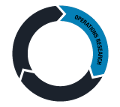Case Studies
The Mutum-Paraná II Bridge project case studies (A, B and C) are a series of three case studies to get acquinted with the complexity of dynamic scheduling using fictitious project data. OR-AS is currently finalizing the first versions of the case studies. More information is coming soon.
The Mumum Paraná II bridge project (A)
This project management case study puts a clear and strong focus on the integration of two dimensions of dynamic project scheduling: baseline scheduling and schedule risk analysis. The analysis of risk on a project baseline schedule is the central theme of the case exercise. The student must evaluate five proposals to cope with risk on a CPM schedule. The calculations and analysis of risk in a baseline schedule are analyzed and the focus should lie on the interpretation of the results and outcome calculations since this will be key to the success of a profound risk analysis.
Status: Testing phase (students at Ghent university). Request more information here.
The Mumum Paraná II bridge project (B)
The primary goal of this second case study is to get acquainted with project scheduling software and to construct a feasible resource-constrained project schedule which is clearly understandable by all project stakeholders. The goal of the student is to go further than submitting software print-outs to the project team. Instead, the purpose is the integration of the resource-constrained scheduling principles within the features of a project scheduling tool in order to provide an easy and understand- able information sheet on the predicted project execution to the various members of a project team.
Status: Currently used by students at Ghent university. See e.g. results here.
The Mumum Paraná II bridge project (C)
The primary goal of this third case study is to get acquainted with the Earned Value Management approach to control projects. The goal of the student is to analyze the data of three projects in progress and to summarize their performance in the best possible way to the management committee. The data allows the incorporation of the Earned Schedule (ES) based Schedule Performance Index (SPI(t)) as an alternative to the traditional SPI metric which shows a unreliable behavior at the end of the project.
Status: Development phase (data generated by ProTrack). Request more information here or download the example files in ProTrack or MS Excel here.
